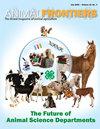Categorizing processing via the Meat Science Lexicon
IF 4.2
2区 农林科学
Q1 AGRICULTURE, DAIRY & ANIMAL SCIENCE
引用次数: 3
Abstract
Consuming any meat requires some level of processing. The process of opening or “shucking” raw oysters would yield the oyster adductor, a muscle often consumed raw, making it one of most minimally processed muscles available from nature and consumed in the developed world. Yet, this minimal level of processing is required to consume this muscle. This was the concept behind the American Meat Science Association’s Lexicon Committee (AMSA, 2017) developing language to divide meat into two major classifications based upon its level of preparation: 1) minimal processing, and 2) further processing. These two major classifications and subsequent subdivisions refer to the level of processing applied to meat when merchandized to the enduser. For the oyster example, opening the shell would be likened to the slaughter process in the meat industry. Removing the muscle from the shell prior to consumption would be comparable to the meat industry jargon of fabrication, which is removing meat from the carcass to cut it into smaller, more useful components. The authors of the Lexicon would recognize cutting into smaller pieces as minimal processing. Adding ingredients, smoking, cooking, and/or canning the oyster meat prior to it being offered to the consumer, would all be considered further processing.通过肉类科学词典对加工进行分类
食用任何肉类都需要一定程度的加工。打开或“剥”生牡蛎的过程会产生牡蛎内收肌,这是一种经常生吃的肌肉,使其成为发达国家从自然界获得和食用的加工程度最低的肌肉之一。然而,消耗这种肌肉需要这种最低水平的处理。这就是美国肉类科学协会词汇委员会(AMSA,2017)开发语言的概念,根据其准备水平将肉类分为两大类:1)最小加工和2)进一步加工。这两个主要分类和随后的细分指的是向最终用户销售时适用于肉类的加工水平。以牡蛎为例,打开牡蛎壳就像肉类行业的屠宰过程。在食用前从胴体中去除肌肉,可以与肉类行业的制造术语相媲美,即从胴体中取出肉,将其切成更小、更有用的成分。Lexicon的作者会认识到,将小块切割成最小的加工量。在向消费者提供牡蛎肉之前,添加配料、吸烟、烹饪和/或罐装牡蛎肉,都将被视为进一步加工。
本文章由计算机程序翻译,如有差异,请以英文原文为准。
求助全文
约1分钟内获得全文
求助全文
来源期刊

Animal Frontiers
Veterinary-Food Animals
CiteScore
6.50
自引率
5.60%
发文量
74
期刊介绍:
Animal Frontiers is the official journal of the following globally active professional animal science societies:
ASAS, the American Society of Animal Science
CSAS, the Canadian Society of Animal Science
EAAP, the European Federation of Animal Science
AMSA, the American Meat Science Association
These organizations are dedicated to the advancement and dissemination of science-based knowledge concerning animal agriculture. Animal Frontiers provides a novel forum for innovative and timely perspectives that have relevance to understanding the complex dynamics at work through animal agriculture. Animal Frontiers publishes discussion and position papers that present several international perspectives on the status of high-impact, global issues in animal agriculture. Every issue will explore a theme of broad and current interest within animal science and animal agriculture.
 求助内容:
求助内容: 应助结果提醒方式:
应助结果提醒方式:


